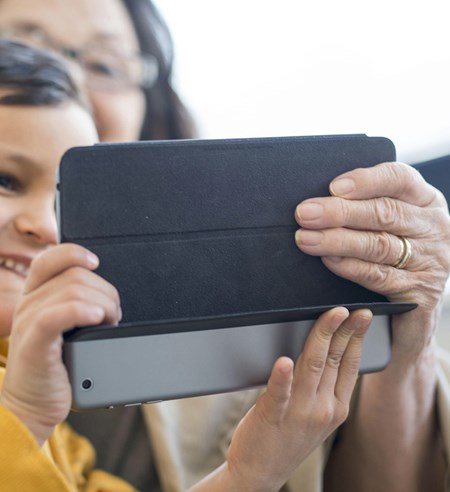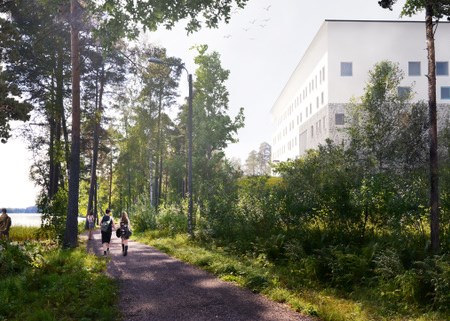Head of design and of d|lab, Tietoevry Banking
The challenge
The world’s elderly population is growing at an unprecedented rate. The global increase in the aged population presents several public health challenges that we need to prepare for. In the future, there will be fewer care providers delivering the elderly care, while at the same time, care providers will increase the treatment and care for patients in their own homes.
The solution
Starting with these societal challenges, we started a joint innovation project with two Swedish municipalities, Malmö City and Kristianstad, with the aim of investigating how to introduce digitalization into the homes of users of a home care service, where a majority are part of the 10% Swedes who currently have limited digital access. The objective was to examine how technology can support staff and users with a focus on three key areas:
- Reducing the number of alarms activated for reasons other than an emergency.
- Increasing the independence and well-being of the elderly.
- Freeing up precious time for employees in the home care service ecosystem.
The first phase of the test period was completed in April 2020. So far Florence is only a prototype and we are excited about continuing the examination and development of the service together with our customers.
A short summary of our findings (pdf) An infographic about inclusive design (.pdf)About the customer
Kristianstad and City of Malmö are two municipalities in the south of Sweden. They have both recognized that solutions like Florence can be beneficial both for improving the overall processes around home care services and for the well-being of individuals that are helped by the services.
Key benefits
Improving the life of the elderly
Gives the elderly more control over their daily life.
Reducing alarm calls
Reduces alarm calls not connected to actual emergencies.
Reducing the workload
Frees up precious time for home care providers.
Get to know Florence
A virtual assistant supporting home care

Video is blocked
The world’s elderly population is growing at an unprecedented rate. The global increase in the aged population presents several public health challenges that we need to prepare for. In the future, there will be fewer care providers delivering the elderly care, while at the same time, care providers will increase the treatment and care for patients in their own homes.
With future trends heading towards more care in the home, it can be expected that the current situation where many elderly people report feelings of loneliness and lack control over their everyday lives will become more prevalent. To combat these feelings, patients often trigger their home care emergency alarm in a bid to gain control or increase social contact.
This increases the workload on already stretched resources delivering home care services. In our study, we found that 25% of alarms are triggered because users, or their relatives, want to ask a question or receive information from the home care service, not because of an emergency.
Digitalization has certainly made life easier for many of us. Yet almost a million Swedes have stated that they almost never or never use the internet This represents almost 10% of Sweden’s population and many of this group fall into the older demographic. Additionally, 27% of women over 75 say they have never used the Internet. (Source SCB)
This 10% is recognized as the most vulnerable citizens in society and the more community services are digitalized, the more the opportunities are limited for them to live independently. This is commonly known as the digital divide, and we are at risk of seeing this growing in our society.
Digitalization has certainly made life easier for many of us. Yet almost a million Swedes have stated that they almost never or never use the internet This represents almost 10% of Sweden’s population and many of this group fall into the older demographic. Additionally, 27% of women over 75 say they have never used the Internet.
SCB - Statistic Sweden
Starting with these societal challenges, we started a joint innovation project with two Swedish municipalities, Malmö City and Kristianstad, with the aim of investigating how to introduce digitalization into the homes of users of a home care service, where a majority are part of the 10% who currently have limited digital access.
The objective was to examine how technology can support staff and users with a focus on three key areas:
- Reducing the number of alarms activated for reasons other than an emergency.
- Increasing the independence and well-being of the elderly.
- Freeing up precious time for employees in the home care service ecosystem.
The first phase of the test period was completed in April 2020. So far Florence is only a prototype and we are excited about continuing the examination and development of the service together with our customers.
A final note about the current context of Coronavirus
This spring has brought new perspectives. We see that digitalization has become a vital tool in helping our most vulnerable citizens; to keep in contact with loved ones, as well as communicating with service providers.
We now face the direct challenge of reducing the 10% gap that separates our elderly from the rest of society. As the young help the old, we see the implementation and success of technologies like Florence being accelerated and introduced to a larger number of elderly people than we thought possible at the beginning of the year.





